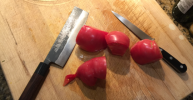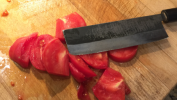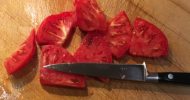Not a necropost, but rather an update to the thread

I went ahead and got some ceramic rods and have been using them on my harder blades. They do indeed work on the harder blades without damaging them, BUT they have their limits. A couple weeks ago I was slicing some nice ripe heirloom tomatoes for a tomato salad, and two of my favorite knives were really struggling - more tearing instead of effortlessly cutting(the knives are a nakiri I recently re-ground the bevels on, and an old Sabatier "Nogent" (I love the feel and balance of that knife)):
View attachment 1419998
So .... I took the ceramic rod to the Nakiri (definitely not the first time, but the most recent of many such touch-ups). the result was a little bit of an improvement, but definitely not where I would want it to be:
View attachment 1419999
So .... I went after the Nogent knife with a steel: it basically performed just the same as the Nakiri with the harder blade:
View attachment 1420000
So .... both knives hit the point where in-kitchen touch-ups just would not bring them back to "effortless sharp". Both were fully sharpened on my grinder at about the same time, and they both hit this "I have got to really sharpen this knife" point at about the same time .... but up until that point I was ok with the ability of either the ceramic rod or steel to touch up each blade in the meantime... So, I am still somewhat stuck with the question of, from an in-kitchen maintainability and usability perspective ... should the statement "harder is better" really be such an absolute statement????
Now, that said, I did last night take the Nakiri to the grinder (I was cutting up a lot of vegetables to grill), and I do have to admit that right off the grinder, the harder steel with the shallower bevel and much smaller BTE thickness is an absolute pleasure to use .... but over time the two more or less converge in performance. So unless a user is truly able to immediately and consistently sharpen a blade ..... is the difference really that absolute?? (for reference, it took me almost 3 weeks between saying "I need to sharpen this" and actually doing so ......)
aside - I am in the process of replicating that Nogent profile in 0.07" thick S35VN. I'm really looking forward to seeing how that blade turns out....



